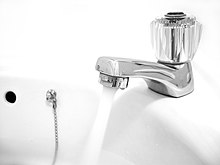Tap water

In most developed nations drinking water is piped to homes and is available on tap. Usually it is safe water.
The provision of tap water requires a massive infrastructure of piping, pumps, and water purification works. The cost of tap water is a small fraction of that of bottled water, often as little as a ten-thousandth.
The same water supply that is used for drinking is also used for washing, flushing water closets (toilets), washing machines, and dishwashers. Experimental attempts have been made to introduce non-potable greywater or rainwater for these secondary uses.
In many areas, fluoride is added to the tap water as a means to improve public dental health. This remains a controversial issue in terms of the health, freedoms and rights of the individual.
The availability of clean tap water brings major public health benefits. Usually, the same administration that provides tap water is also responsible for the removal and treatment before discharge or reclamation of wastewater.
Delivery system
This section needs expansion. You can help by adding to it. |
Tap water use
According to a 1999 American Water Works Association Research Foundation study on residential end uses of water in the United States, Americans drink more than 1 billion glasses of tap water per day. Daily indoor per capita water use in a typical single family home is 69.3 gallons (260 litres). Overall use falls into the following categories:
- body cleanliness:
- washing:
- Clothes Washers - 21.7%
- Dishwashers - 1.4%
- Faucets - 15.7%
- Leaks - 12.7%
- Other Domestic Uses - 2.2%
Trivia
Tap water may contain different types of metal ions; the area of the world one lives in is a determining factor of this.
See also
External links
- US Environmental Protection Agency Drinking water page
- American Water Works Association for professionals in water production and distribution and other water fields.
- Safe Water for International Travelers to see water quality worldwide.
- Bottled Water: Better than the Tap? - A Food and Drug Administration site, explains different sources & treatment of water in depth and compares them.
- E the Environmental Magazine piece on bottled water (Oct 2003).
